Author: Thitpin Podcast
The Inside Out Perspective: Using Mindfulness Based Techniques to Connect with Nature
Chimes in the distance sway to the wind and make rhythmic melodies. Ladies, dressed in white, greet me as I make my way over to the main meditation building. Their palms gently pressing against one another and their backs bent forward in unison to give a bow. In Buddhism, bowing to a person is a gesture to show respect – an act of welcoming. For the self, it is a mindful gesture – a physical expression to let go of the ego and connect to the present moment, showing reverence for the Buddha’s teachings.
The combination of hearing the chimes and seeing the ladies relaxes my body. Time seems to dissipate and my daily life becomes a memory – foggy and afar. You wouldn’t assume that in an agricultural area within the Forest of Dean, an area predominantly made up of farmers and their farms, grazing sheep and moo-ing cows stands a monastery with a culture entirely different to its neighbours. Yet, here it stands, in a land made of paddocks that are absent of horses and quintessentially British farmstead and outbuildings.

Parking area, communal kitchen and accommodation building behind, at the monastery
The presiding feeling at Oxford Buddha Vihara in the Forest of Dean is one of laughter and community. Once a month over a weekend, resident monks, loyal devotees, and curious partakers come together to meditate and listen to Dharma teachings. This is a necessary form of connection that opens hearts and prepares everyone to go inwards and observe our minds.
Growing up as a Buddhist, I learned how to pray through chanting and prayer beads. My first introduction to meditation was from my mother. Throughout my university years and later, when I was working, using what she had taught me, I dabbled into sitting meditation, flowing in and out of an inquiry to my body and mind. In time, my first formal teaching would come from the monks at Oxford Buddha Vihara. It is here that I learned how to observe my thoughts, connect with my breath, and expand my compassion.
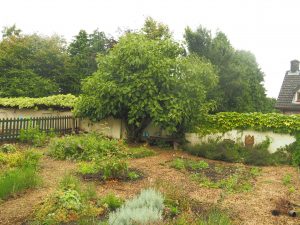
Communal kitchen garden/ growing area
When I go to the monthly meditation weekends, time seems to stretch for longer than two days, and I come away feeling a sense of stillness. Other times, I’m wrestling with my thoughts from the beginning until the end with no sense of resolution; feeling defeated in my quest to find the ultimate form of peace. The peace that will allow me to connect in a grounded way, to myself and with the world around me. But I kept going. Over time, sitting meditation and the practice of daily mindfulness brought me closer to myself and finally, to have a better connection with the outside world. Better yet, my practice now allows me to quiet the monkey brain to engage in productive work.
You see, meditation is not a form of escapism and to feel peace. It is about connecting directly with what is happening at the present moment with full acceptance. There has never been a better time to practice meditation and daily mindfulness. It isn’t just for ourselves but for the wider world, for our nature and our ecology need more mindful people.
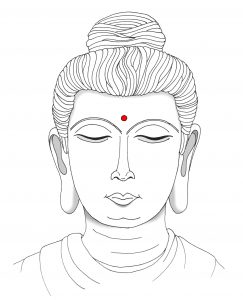
Illustration of the Buddha by Sarah Jane Pullen, www.sarahjaneartuk.com
30 minutes of mindful meditation a day can grow the hippocampus. The hippocampus is a structure of the brain embedded in both of the cerebral hemispheres, regulating our emotions, learning, memory and motivation. This time spent also reduces the grey matter in the amygdala. Amygdala, meaning almond shaped, is a collection of nuclei in both sides of the brain. It is most commonly associated with the control of fear. When encountering a stressful or fearful situation, notice your increase in heart rate, sweating or pupil dilation. These almond shaped cerebral parts of our brain are responsible for this. Meditation creates a pause in the system loop and makes us act less with fight or flight responses to such situations.
Our world currently is in a flux of digital stimuli and information. Fear is presiding within our communities. We feel helpless. We don’t know where to begin. I would like to invite you to pause. Pause, not to disengage with what is happening but to re-engage. Venerable Dr Khammai Dhammasami, the Abbot of Oxford Buddha Vihara recalls that the Buddha said our suffering was down to fear, greed, anger and delusion – the negative roots of the mind. When we become this way, this will affect the environment – environment in the sense of our natural, social, political, and so forth. This invitation to pause involves connecting first with ourselves then with our natural environment as a way to re-engage with everything else. Restoration in nature is fundamental to our mental and physical wellbeing.
Gathered from my daily practice and mindfulness techniques learned from the monastery, I have collated the following minimalistic approaches to guide you to connect with nature:
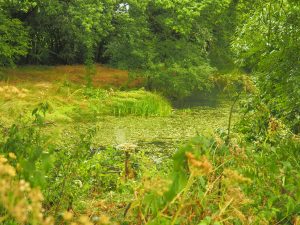
Abundance of natural landscape elements provide the ideal place to connect with nature
- Deep breaths
The ebb and flow of life, the cyclic intelligence of nature, also exist in us. Our breathing is the reason why we are alive, yet so very often we take this for granted. Begin to connect with your body with deep breaths in and out. Feel the expansion and contraction resulting from these actions. From having this first connection, you can start to explore other aspects of the breath. Where does your breath hit when coming in and out? Does it feel warm or cool? You can allow your breathing to come to its natural state, breathing without force, when you feel more connected with the process.
- Sensory awareness
Extending from the noticing of the breath, you can connect with the sensory aspects of your body. Much information dissolves into our senses from the outside world every second. When outside, notice what you hear – is it sounds of birds, traffic, people talking, water moving? Can you pick out any subtle to distinctive smells? If you see a scented plant, you may wish to go up to it and take in the scent. How does your body feel – is it cold from the presently harsh wind? Can you feel the sun rays brushing against on your skin?
- Non-judgmental approach
The monkey brain is an aspect of us that will not cease; in fact, it is a natural process of the mind to think constantly (some of us do it more than others). The important thing here is to not judge. Noticing your breath and becoming aware of your senses might stir emotions within you that feeds into mind chatter. Are you remembering what you need to do once you are back at work? What about that time someone did something to annoy you? When realising that your monkey brain is active, just summarise them as simply “thoughts” or “I am thinking”. You can even repeat “thinking, thinking, thinking.” This allows distance between your thoughts and you so that you can go back to the breath and these senses.
- Connect to the wider spatial elements
It is a really practical process sometimes to remind yourself that you live in on Earth, to which beyond that exists the wider network of galaxies of stars and other planets. I remind myself by often looking up at the sky during day and night time. During the day, look up at the clouds, which are transient in nature and constantly moving. Pick out the different pallets of colours painting the sky, the speed of the clouds determined by the wind and the shapes they form. At night, do some star gazing. Learn about constellations- can you spot the Orion’s belt, or the planet Venus, which is the brightest planet in March’s night sky?
Not only does this give us a sense of awe and wonder but also humility. Other magnificent features of nature also give way to similar feelings. Stand under a tree and look up! The underside of the tree canopies, I find, are so intricate and interesting. There are patterns to be found.

Abundance of mature trees with characters
- People and wildlife watching
By this point, you may feel ready to absorb other uncontrollable yet happening events. Watch your fellow humans going about their day. Human behaviour is fascinating – our quirks, gestures, and ways of connecting. Observing wildlife is also interesting – the nearest animals around you may just be pigeons or squirrels. The very act of observing people and animal’s behaviour brings us out of our inner world and into others that we share the space on Earth with.
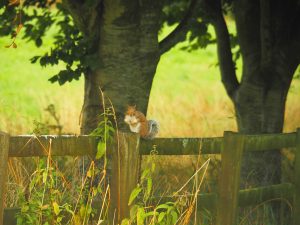
Squirrel spotting- wildlife is abundant at the monastery
- Compassion
Venerable Dr Khammai Dhammasami teaches on compassion meditation. Our past experiences dictate our likes and dislikes, which feed into the judgmental mind. Mindfulness allows us to notice this and using compassion we can expand our level of tolerance and acceptance to the person or situation at hand. Compassion is developing feelings of loving kindness and well wishing. The easiest way is to start with those you find easy to share this feeling such as a close friend or family member. Then you can, bit by bit, begin to expand your circle of compassion to others. This is a good approach for developing your empathy and to deal with others of opposing views when challenged by biggest topics of our present day.
-
- Walking meditation
Practicing sitting meditation involves much of the points above. However, walking meditation is slightly different. I was taught how to do this by two of the long-term attendees during a weekend mediation. We can take our feet for granted. These two points of connection to the ground have carried us along huge distances in our lifetimes. It is in doing the walking meditation that I started to notice the subtle act of balancing, which happens as we walk. In the process of putting our foot to the ground, do it slowly, first with your heel landing and rolling onto the other parts of the foot. Allow yourself to be fully present in the act, for each step, and if a thought comes into your mind, stop walking. Mindfully become aware of the thinking process, as explained in point number 3, then continue walking mindfully once the thought has ceased.
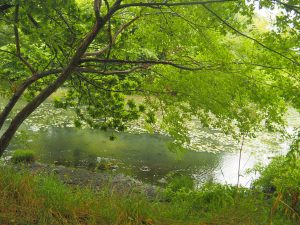
Large pond provides a perfect place for observation
On one autumn Sunday, I load my sleeping bag in my car; I turn on my Sat Nav to take me back home. I don’t feel quite ready to leave – the monastery has been inviting and the weekend too relaxing. Whilst it is not a solitary place but one of community, Oxford Buddha Vihara provides the space for discovering my solitude. I am a little more present and grounded, braver and more equipped to deal with the world around me. May these mindfulness techniques allow you to find the right questions to begin to resolve the most difficult issues of our times.
Listen to the full interview with Venerable Dr Khammai Dhammasami here.
For more episodes, you can check out Thitpin Podcast on Apple Podcasts, Spotify and other platforms.




